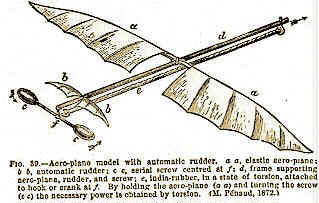Model making technique and history
 The building of model aircraft as a hobby it became popular at the beginning of the 20th century. As early as 1913 Biegenwald's book "Flugmodellbau" was published. The rubber motor was recommended as the drive and the possible use of compressed air, CO2 and V combustion engines rudimentarily called. Alphonse Pénaud (1850-1880) was a French air technician. Through his work he gained extensive knowledge of flight technology. He invented which are still used today in model sports rubber motor . The real beginning of free flight was in 1871, when he flew by one Rubber motor with 5g powered flight model "Planophore" in about 13 seconds a distance of 60 m 480 mm, wing depth 110 mm, length 500 mm, total weight 16 g. The propeller had a speed of 250 rpm. His model, with aerodynamic features, had a stabilizing fin in addition to the wing, at the time " Called the Penaud Tax ". It corresponds to the current one tailplane . Today we would refer to this model as a hall flight model. The building of model aircraft as a hobby it became popular at the beginning of the 20th century. As early as 1913 Biegenwald's book "Flugmodellbau" was published. The rubber motor was recommended as the drive and the possible use of compressed air, CO2 and V combustion engines rudimentarily called. Alphonse Pénaud (1850-1880) was a French air technician. Through his work he gained extensive knowledge of flight technology. He invented which are still used today in model sports rubber motor . The real beginning of free flight was in 1871, when he flew by one Rubber motor with 5g powered flight model "Planophore" in about 13 seconds a distance of 60 m 480 mm, wing depth 110 mm, length 500 mm, total weight 16 g. The propeller had a speed of 250 rpm. His model, with aerodynamic features, had a stabilizing fin in addition to the wing, at the time " Called the Penaud Tax ". It corresponds to the current one tailplane . Today we would refer to this model as a hall flight model.
Building materials were first and foremost everyone types of wood . Plywood, thin pine strips and paper to cover the wings. later the light and easily machinable but nonetheless tough spread balsa wood . Today, plastics like GRP fiber composite - and Foam molded parts and plastic films are used to create the surface and the finish. Already in the 1930s internal combustion engines introduced for model aircraft. B. the Kratmo engine. The first successful radio-controlled experiments were carried out in the second half of the 1930s. away 1950 were remote controls first as bulky, bulky and heavy tube devices, which required large and unwieldy batteries, later with me Transistors widespread through industrial manufacturing. But only from the mid-1960s Proportional systems introduced years ago, in which each rudder corresponds exactly to the deflection of the stick movement Sender follows, with which especially model aircraft can be controlled precisely and safely, really made model flying popular and widespread in society. Milestones in model aircraft construction / Excerpt
1848: John Stringfellow built a free-flying powered flight model, "Triplane" which he took from a launch pad started in 1857: After model tests, the French brothers du Temple de la Croix received a patent for a Motorized airplane
1871: The Frenchman Alphonse Pénaud builds his Planaphore, a free-flying one Motorized model airplane with rubber motor drive.
1875: The Englishman Thomas Moy tests a tethered powered airplane model with steam engine drive and 4 m span.
1877: First flight of a steam-powered model helicopter from Enrico Forlanini
1879: The Frenchman Victor Tatin builds a powered airplane model with propellers and a compressed air motor, that successfully performs ground starts.
....
2003: The flight model TAM (Trans-Atlantic Model 5) from Maynard Hill crosses the North Atlantic in non-stop flight.
The list with all historical events is here to find
|